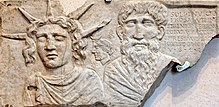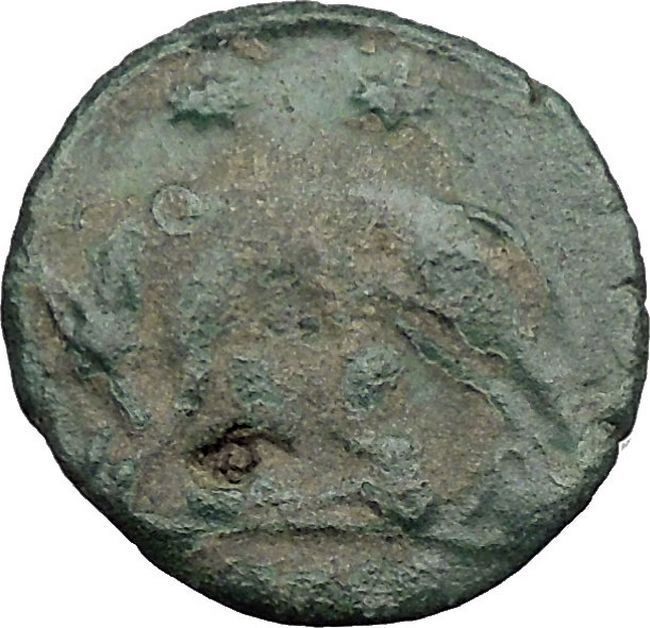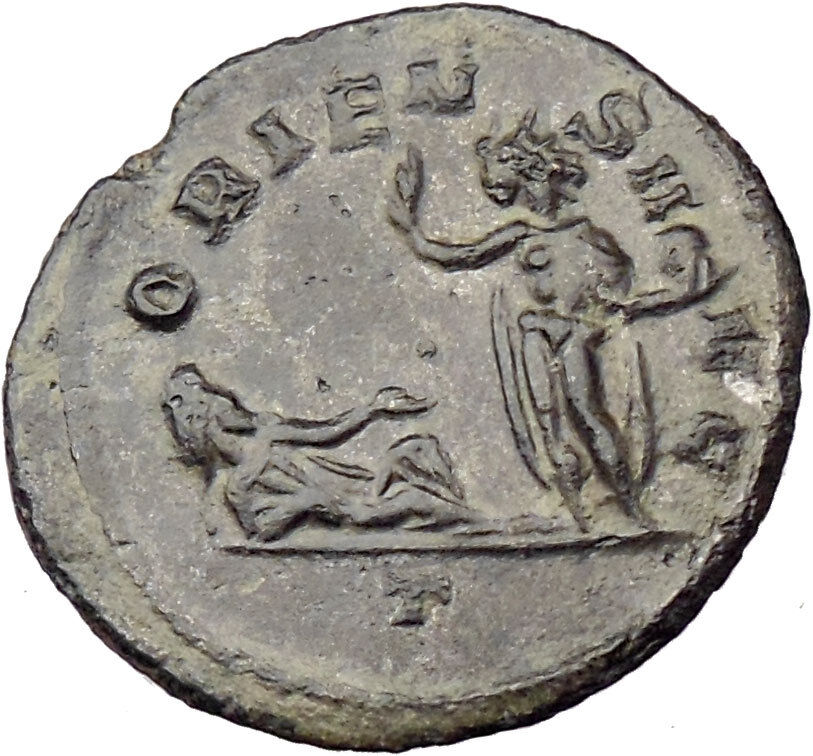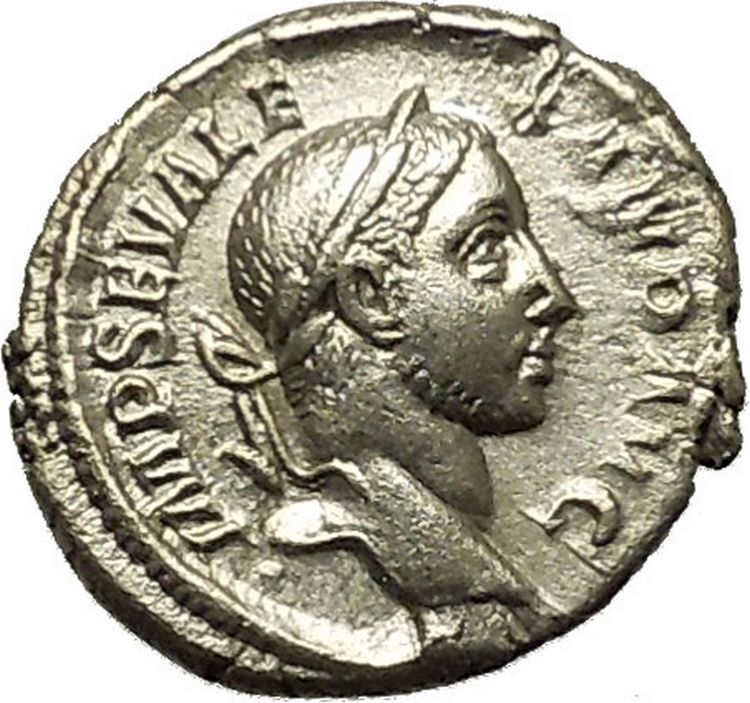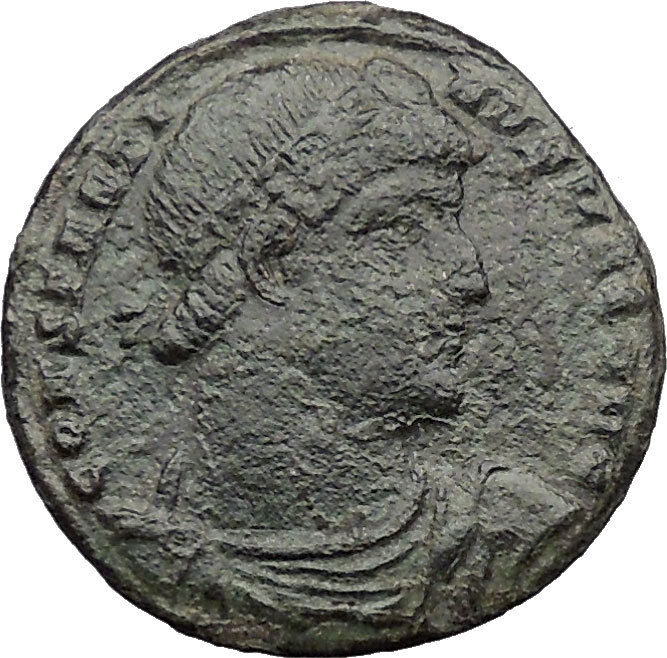|
Severus Alexander
–
Roman Emperor
: 222-235 A.D.
Silver Denarius 20mm (3.17 grams) Rome mint: 232 A.D.
Reference: RIC 112c
IMPALEXANDERPIVSAVG – Laureate, draped bust right.
PMTRPXICOSIIIPP –
Sol
advancing left, raising hand and holding whip.
You are bidding on the exact item pictured,
provided with a Certificate of Authenticity and Lifetime Guarantee of
Authenticity.
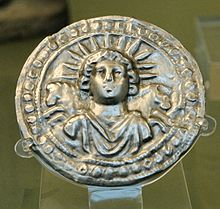
Roman Imperial
repoussé
silver
disc of Sol Invictus (3rd
century), found at
Pessinus
(British
Museum) Sol Invictus (“Unconquered Sun”) was the official
sun god
of the later
Roman Empire
and a patron of soldiers. In 274
the Roman emperor
Aurelian
made it an official
cult alongside the traditional Roman cults. Scholars disagree whether
the new deity was a refoundation of the ancient
Latin
cult of
Sol
,
a revival of the cult of
Elagabalus
or completely new.The god was
favored by emperors after Aurelian and appeared on their coins until
Constantine
.The last inscription referring to
Sol Invictus dates to 387 AD and there were enough devotees in the 5th century
that
Augustine
found it necessary to preach against
them.
It is commonly claimed that the date of 25 December for
Christmas
was selected in order to correspond
with the Roman festival of Dies Natalis Solis Invicti, or “Birthday of
the Unconquered Sun”, but this view is challenged
Invictus as
epithet
Invictus
(“Unconquered, Invincible”) was an
epithet
for
several deities
of
classical Roman religion
, including the supreme
deity
Jupiter
, the war god
Mars
,
Hercules
,
Apollo
and
Silvanus
.[8]
Invictus was in use from the 3rd century BC, and was well-established as
a
cult
title when applied to
Mithras
from the 2nd century onwards. It has a
clear association[vague]
with solar deities and solar monism; as such, it became the preferred epithet of
Rome’s traditional
Sol
and the novel, short-lived Roman state cult
to
Elagabalus
, an
Emesan
solar deity who headed Rome’s official
pantheon under his
namesake emperor
.
The earliest dated use of Sol invictus is in a dedication from Rome,
AD 158. Another, stylistically dated to the 2nd century AD, is inscribed on a
Roman
phalera
: “inventori lucis soli invicto
augusto” (to the contriver of light, sol invictus augustus ). Here
“augustus” is most likely a further epithet of Sol as “august” (an elevated
being, divine or close to divinity), though the association of Sol with the
Imperial house would have been unmistakable and was already established in
iconography and stoic monism. These are the earliest attested examples of Sol as
invictus, but in AD 102 a certain
Anicetus
restored a shrine of Sol; Hijmans
(2009, 486, n. 22) is tempted “to link Anicetus’ predilection for Sol with his
name, the
Latinized
form of the Greek word ἀνίκητος,
which means invictus“.
Elagabalus
The first sun god consistently termed invictus was the
provincial Syrian
god
Elagabalus
. According to the
Historia Augusta
, the
teenaged Severan heir
adopted the name of his
deity and brought his cult image from Emesa to Rome. Once installed as emperor,
he neglected Rome’s traditional State deities and promoted his own as Rome’s
most powerful deity. This ended with his murder in 222.
The Historia Augusta refers to the deity Elagabalus as “also called
Jupiter and Sol” (fuit autem Heliogabali vel Iovis vel Solis).This has
been seen as an abortive attempt to impose the Syrian sun god on Rome;
but because it is now clear that the Roman cult of Sol remained
firmly established in Rome throughout the Roman period,this Syrian
Sol Elagabalus
has become no more relevant to
our understanding of the Roman
Sol
than, for example, the Syrian
Jupiter Dolichenus
is for our understanding of
the Roman Jupiter.
Aurelian
The Roman gens
Aurelian was associated with the cult
of Sol. After his victories in the East, the Emperor
Aurelian
thoroughly reformed the Roman cult of
Sol, elevating the sun-god to one of the premier divinities of the Empire. Where
previously priests of Sol had been simply
sacerdotes
and tended to belong to lower
ranks of Roman society, they were now pontifices and members of the new
college of pontifices
instituted by Aurelian.
Every pontifex of Sol was a member of the senatorial elite, indicating that the
priesthood of Sol was now highly prestigious. Almost all these senators held
other priesthoods as well, however, and some of these other priesthoods take
precedence in the inscriptions in which they are listed, suggesting that they
were considered more prestigious than the priesthood of Sol.Aurelian also built
a new temple for Sol, bringing the total number of temples for the god in Rome
to (at least) four[21]
He also instituted games in honor of the sun god, held every four years from AD
274 onwards.
The identity of Aurelian’s Sol Invictus has long been a subject of scholarly
debate. Based on the
Historia Augusta
, some scholars have argued
that it was based on
Sol Elagablus
(or Elagabla) of
Emesa
. Others, basing their argument on
Zosimus
, suggest that it was based on the
Helios
, the solar god of
Palmyra
on the grounds that Aurelian placed and
consecrated a cult statue of Helios looted from Palmyra in the temple of Sol
Invictus. Professor Gary Forsythe discusses these arguments and add a third more
recent one based on the work of Steven Hijmans. Hijmans argues that Aurelian’s
solar deity was simply the traditional Greco-Roman Sol Invictus.
Constantine
Emperors portrayed Sol Invictus on their official coinage, with a wide range
of legends, only a few of which incorporated the epithet invictus, such
as the legend SOLI INVICTO COMITI, claiming the Unconquered Sun
as a companion to the Emperor, used with particular frequency by Constantine.
Statuettes of Sol Invictus, carried by the standard-bearers,
appear in three places in reliefs on the
Arch of Constantine
. Constantine’s official
coinage continues to bear images of Sol until 325/6. A
solidus
of Constantine as well as a gold
medallion from his reign depict the Emperor’s bust in profile twinned (“jugate”)
with Sol Invictus, with the legend INVICTUS CONSTANTINUS
Constantine decreed (March 7, 321) dies Solis—day of the sun, “Sunday“—as
the Roman day of rest [CJ3.12.2]:
- On the venerable day of the Sun let the magistrates and people residing
in cities rest, and let all workshops be closed. In the country however
persons engaged in agriculture may freely and lawfully continue their
pursuits because it often happens that another day is not suitable for
grain-sowing or vine planting; lest by neglecting the proper moment for such
operations the bounty of heaven should be lost.
Constantine’s triumphal arch was carefully positioned to align with the
colossal statue of Sol
by the
Colosseum
, so that Sol formed the dominant
backdrop when seen from the direction of the main approach towards the arch.[26]
Sol and the
other Roman Emperors
Berrens
deals with coin-evidence of Imperial connection to the Solar
cult. Sol is depicted sporadically on imperial coins in the 1st and 2nd
centuries AD, then more frequently from
Septimius Severus
onwards until AD 325/6.
Sol invictus appears on coin legends from AD 261, well before the reign of
Aurelian.
Connections between the imperial radiate crown and the cult of
Sol are postulated.
Augustus
was posthumously depicted with radiate
crown, as were living emperors from
Nero (after AD 65) to
Constantine
. Some modern scholarship interprets
the imperial radiate crown as a divine, solar association rather than an overt
symbol of Sol; Bergmann calls it a pseudo-object designed to disguise the divine
and solar connotations that would otherwise be politically controversial
but there is broad agreement that coin-images showing the
imperial radiate crown are stylistically distinct from those of the solar crown
of rays; the imperial radiate crown is depicted as a real object rather than as
symbolic light. Hijmans argues that the Imperial radiate crown represents the
honorary wreath awarded to
Augustus
, perhaps posthumously, to commemorate
his victory at the
battle of Actium
; he points out that
henceforth, living emperors were depicted with radiate crowns, but state divi
were not. To Hijmans this implies the radiate crown of living emperors as a link
to Augustus. His successors automatically inherited (or sometimes acquired) the
same offices and honours due to Octavian as “saviour of the Republic” through
his victory at Actium, piously attributed to Apollo-Helios. Wreaths awarded to
victors at the Actian Games were radiate.
Sol
Invictus and Christianity and Judaism

Mosaic of Christ as
Sol
or
Apollo-Helios
in Mausoleum M in the
pre-4th-century necropolis beneath[33]
St. Peter’s in the Vatican
, which
many interpret as representing Christ
The
Philocalian calendar
of AD 354 gives a festival
of “Natalis Invicti” on 25 December. There is limited evidence that this
festival was celebrated before the mid-4th century.
The idea that Christians chose to celebrate the birth of Jesus on 25 December
because this was the date of an already existing festival of the Sol Invictus
was expressed in an annotation to a manuscript of a work by 12th-century Syrian
bishop
Jacob Bar-Salibi
. The scribe who added it
wrote: “It was a custom of the Pagans to celebrate on the same 25 December the
birthday of the Sun, at which they kindled lights in token of festivity. In
these solemnities and revelries the Christians also took part. Accordingly when
the doctors of the Church perceived that the Christians had a leaning to this
festival, they took counsel and resolved that the true Nativity should be
solemnised on that day.”
This idea became popular especially in the 18th and 19th centuries
and is still widely accepted.
In the judgement of the Church of England Liturgical Commission, this view
has been seriously challenged
by a view based on an old tradition, according to which the
date of Christmas was fixed at nine months after 25 March, the date of the
vernal equinox, on which the
Annunciation
was celebrated.
The Jewish calendar date of 14 Nisan was believed to be that
of the beginning of creation, as well as of the Exodus and so of Passover, and
Christians held that the new creation, both the death of Jesus and the beginning
of his human life, occurred on the same date, which some put at 25 March in the
Julian calendar.[40][42][43]
It was a traditional Jewish belief that great men lived a whole number of years,
without fractions, so that Jesus was considered to have been conceived on 25
March, as he died on 25 March, which was calculated to have coincided with 14
Nisan.[44]
Sextus Julius Africanus
(c.160 – c.240) gave 25
March as the day of creation and of the conception of Jesus.
The tractate De solstitia et aequinoctia conceptionis et
nativitatis Domini nostri Iesu Christi et Iohannis Baptistae falsely
attributed to
John Chrysostom
also argued that Jesus was
conceived and crucified on the same day of the year and calculated this as 25
March.
A passage of the Commentary on the prophet Daniel by
Hippolytus of Rome
, written in about 204, has
also been appealed to.
Among those who have put forward this view are Louis Duchesne,Thomas J.
Talley, David J. Rothenberg, J. Neil Alexander, and Hugh Wybrew.
Not all scholars who view the celebration of the birth of Jesus on 25
December as motivated by the choice of the winter solstice rather than
calculated on the basis of the belief that he was conceived and died on 25 March
agree that it constituted a deliberate Christianization of a festival of the
Birthday of the Unconquered Sun. Michael Alan Anderson writes:
Both the sun and Christ were said to be born anew on December 25. But
while the solar associations with the birth of Christ created powerful
metaphors, the surviving evidence does not support such a direct association
with the Roman solar festivals. The earliest documentary evidence for the
feast of Christmas makes no mention of the coincidence with the winter
solstice. Thomas Talley has shown that, although the Emperor Aurelian’s
dedication of a temple to the sun god in the Campus Martius (C.E. 274)
probably took place on the ‘Birthday of the Invincible Sun’ on December 25,
the cult of the sun in pagan Rome ironically did not celebrate the winter
solstice nor any of the other quarter-tense days, as one might expect. The
origins of Christmas, then, may not be expressly rooted in the Roman
festival.
The same point is made by Hijmans: “It is cosmic symbolism…which inspired
the Church leadership in Rome to elect the southern solstice, December 25, as
the birthday of Christ … While they were aware that pagans called this day the
‘birthday’ of Sol Invictus, this did not concern them and it did not play any
role in their choice of date for Christmas.” He also states that, “while the
winter solstice on or around December 25 was well established in the Roman
imperial calendar, there is no evidence that a religious celebration of Sol on
that day antedated the celebration of Christmas”.
The Oxford Companion to Christian Thought also remarks on the
uncertainty about the order of precedence between the celebrations of the
Birthday of the Unconquered Sun and the birthday of Jesus: “This ‘calculations’
hypothesis potentially establishes 25 December as a Christian festival before
Aurelian’s decree, which, when promulgated, might have provided for the
Christian feast both opportunity and challenge.”
Susan K. Roll also calls “most extreme” the unproven hypothesis that “would
call Christmas point-blank a ‘christianization’ of Natalis Solis Invicti, a
direct conscious appropriation of the pre-Christian feast, arbitrarily placed on
the same calendar date, assimilating and adapting some of its cosmic symbolism
and abruptly usurping any lingering habitual loyalty that newly-converted
Christians might feel to the feasts of the state gods”.
The comparison of Christ with the astronomical
Sun
is common in ancient Christian writings.
In the 5th century,
Pope Leo I
(the Great) spoke in several sermons
on the Feast of the Nativity of how the celebration of Christ’s birth coincided
with increase of the sun’s position in the sky. An example is: “But this
Nativity which is to be adored in heaven and on earth is suggested to us by no
day more than this when, with the early light still shedding its rays on nature,
there is borne in upon our senses the brightness of this wondrous mystery.
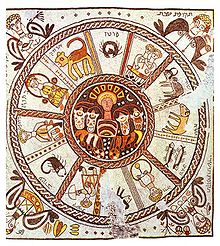
Mosaic in the
Beth Alpha
synagogue, with the sun
in the centre, surrounded by the twelve zodiac constellations and
with the four seasons associated inaccurately with the
constellations
A study of
Augustine of Hippo
remarks that his exhortation
in a Christmas sermon, “Let us celebrate this day as a feast not for the sake of
this sun, which is beheld by believers as much as by ourselves, but for the sake
of him who created the sun”, shows that he was aware of the coincidence of the
celebration of Christmas and the Birthday of the Unconquered Sun, although this
pagan festival was celebrated at only a few places and was originally a
peculiarity of the Roman city calendar. It adds: “He also believes, however,
that there is a reliable tradition which gives 25 December as the actual date of
the birth of our Lord.”
By “the sun of righteousness” in
Malachi 4:2
“the
fathers
, from
Justin
downward, and nearly all the earlier
commentators understand Christ, who is supposed to be described as the
rising sun”.
The
New Testament
itself contains a hymn fragment:
“Awake, O sleeper, and arise from the dead, and Christ will shine on you.”
Clement of Alexandria
wrote of “the Sun of the
Resurrection, he who was born before the dawn, whose beams give light”.
Christians adopted the image of the Sun (Helios
or Sol Invictus) to represent Christ. In this portrayal he is a beardless figure
with a flowing cloak in a chariot drawn by four white horses, as in the mosaic
in Mausoleum M discovered under
Saint Peter’s Basilica
and in an
early-4th-century catacomb fresco.
Clement of Alexandria had spoken of Christ driving his chariot
in this way across the sky. The nimbus of the figure under Saint Peter’s
Basilica is described by some as rayed,
as in traditional pre-Christian representations, but another
has said: “Only the cross-shaped nimbus makes the Christian significance
apparent” (emphasis added). Yet another has interpreted the figure as a
representation of the sun with no explicit religious reference whatever, pagan
or Christian.
The traditional image of the sun is used also in Jewish art. A mosaic floor
in Hamat Tiberias
presents
David
as Helios surrounded by a ring with the
signs of the zodiac
.As well as in Hamat Tiberias, figures of
Helios or Sol Invictus also appear in several of the very few surviving schemes
of decoration surviving from Late Antique
synagogues
, including
Beth Alpha
,
Husefah
(Husefa) and
Naaran
, all now in
Israel
. He is shown in floor mosaics, with the
usual radiate halo, and sometimes in a
quadriga
, in the central roundel of a circular
representation of the zodiac or the seasons. These combinations “may have
represented to an agricultural Jewish community the perpetuation of the annual
cycle of the universe or … the central part of a calendar”.
Marcus
Aurelius Severus Alexander (October 1, 208–March 18, 235 AD), commonly
called Alexander Severus, was the last
Roman emperor
(11 March 222–235) of the
Severan dynasty
. Alexander Severus succeeded his cousin,
Elagabalus
upon the latter’s assassination in 222 AD, and was ultimately assassinated
himself, marking the
epoch event
for the
Crisis of the Third Century
—nearly fifty years of disorder, Roman civil
wars, economic chaos, regional rebellions, and external threats that brought the
Empire to near-collapse.
Alexander Severus was the
heir
apparent
to his cousin, the eighteen-year-old Emperor who had been murdered
along with his mother by his own guards—and as a mark of contempt, had their
remains cast into the
Tiber river
. He and his cousin were both grandsons of the influential and
powerful Julia Maesa
, who had arranged for Elagabalus’ acclamation as Emperor by the
famed
Third Gallic Legion
.
A rumor of Alexander’s death circulated, triggering the assassination of
Elagabalus.
Alexander’s reign was marked by troubles. In military conflict against the
rising
Sassanid Empire
, there are mixed accounts, though the Sassanid threat was
checked. However, when campaigning against
Germanic tribes
of
Germania
,
Alexander Severus apparently alienated his legions by trying diplomacy and
bribery, and they assassinated him.
Life
Alexander was born with the name Marcus Julius Gessius Bassianus Alexianus.
Alexander’s father,
Marcus Julius Gessius Marcianus
was a Syrian
Promagistrate
. His mother
Julia Avita Mamaea
was the second daughter of
Julia
Maesa
and Syrian noble
Julius Avitus
and maternal aunt of Emperor
Elagabalus
.
He had an elder sister called Theoclia and little is known about her.
Alexander’s maternal great-aunt was empress
Julia
Domna
(also Maesa’s younger sister) and his great-uncle in marriage was
emperor Lucius
Septimius Severus
. Emperors
Caracalla
and
Publius Septimius Geta
, were his mother’s maternal cousins. In 221,
Alexander’s grandmother, Maesa, persuaded the emperor to adopt his cousin as
successor and make him
Caesar
and Bassianus changed his name to Alexander. In the following
year, on March 11, Elagabalus was murdered, and Alexander was proclaimed emperor
by the
Praetorians
and accepted by the Senate.
When Alexander became emperor, he was young, amiable, well-meaning, and
entirely under the dominion of his mother. Julia Mamaea was a woman of many
virtues, and she surrounded the young emperor with wise counsellors. She watched
over the development of her son’s character and improved the tone of the
administration. On the other hand, she was inordinately jealous. She also
alienated the army by extreme parsimony, and neither she nor her son were strong
enough to impose military discipline. Mutinies became frequent in all parts of
the empire; to one of them the life of the jurist and praetorian praefect
Ulpian
was
sacrificed; another compelled the retirement of
Cassius
Dio
from his command.
On the whole, however, the reign of Alexander was prosperous until the rise,
in the east, of the
Sassanids
. Of the war that followed there are various accounts. (Mommsen
leans to that which is least favourable to the Romans). According to Alexander’s
own dispatch to the senate, he gained great victories. At all events, though the
Sassanids were checked for the time, the conduct of the Roman army showed an
extraordinary lack of discipline. The emperor returned to
Rome and celebrated
a triumph in 233.
The following year he was called to face German invaders in
Gaul, who had
breached the Rhine frontier in several places, destroying forts and over-running
the countryside. Alexander mustered his forces, bringing legions from the
eastern provinces, and crossed the Rhine into Germany on a pontoon bridge.
Initially he attempted to buy the German tribes off, so as to gain time. Whether
this was a wise policy or not, it caused the Roman legionaries to look down on
their emperor as one who was prepared to commit unsoldierly conduct.
Herodian
says “in their opinion Alexander showed no honourable intention to pursue the
war and preferred a life of ease, when he should have marched out to punish the
Germans for their previous insolence”. These circumstances drove the army to
look for a new leader. They chose
Gaius Iulius Verus Maximinus
, a Thracian soldier who had worked his way up
through the ranks.
Following the nomination of Maximinus as emperor, Alexander was slain (on
either March 18 or March 19, 235), together with his mother, in a mutiny of the
Primigenia Legio XXII
. These assassinations secured the throne for
Maximinus.
The death of Alexander is considered as the end of the Principate
system established by
Augustus
.
Although the Principate continued in theory until the reign of
Diocletian
,
Alexander Severus’ death signalled the beginning of the chaotic period known as
the
Crisis of the Third Century
which weakened the empire considerably.
Legacy
Alexander was the last of the Syrian emperors. Under the influence of his
mother, he did much to improve the morals and condition of the people. His
advisers were men like the famous jurist Ulpian, the historian Cassius Dio and a
select board of sixteen senators; a municipal council of fourteen assisted the
urban praefect in administering the affairs of the fourteen districts of Rome.
The luxury and extravagance that had formerly been so prevalent at the court
were put down; the standard of the coinage was raised; taxes were lightened;
literature, art and science were encouraged; the lot of the soldiers was
improved; and, for the convenience of the people, loan offices were instituted
for lending money at a moderate rate of interest.
In religious matters Alexander preserved an open mind. It is said that he was
desirous of erecting a temple to the
founder of
Christianity
, but was dissuaded by the pagan priests.
Marriage
Alexander was married three times. His most famous wife was
Sallustia Orbiana
,
Augusta
, whom he married in 225. He divorced and exiled her in 227,
after her father,
Seius Sallustius
, was executed for attempting to assassinate the emperor.
Another wife was Sulpicia Memmia. Her father was a man of consular rank; her
grandfather’s name was Catulus.
The Principate
Julio-Claudian
dynasty
|
Reign
|
Incumbent
|
Notes
|
|
16 January 27 BC to 19 August AD 14
|
Augustus
|
|
|
19 August 14 to 16 March 37
|
Tiberius
|
|
|
18 March 37 to 24 January 41
|
Caligula
|
Murdered by Praetorian Guard
|
|
24 January 41 to 13 October 54
|
Claudius
|
Poisoned by his wife Agrippina, mother of Nero
|
|
13 October 54 to 11 June 68
|
Nero
|
Made a slave kill him
|
Year
of the Four Emperors (Civil War)
|
Reign
|
Incumbent
|
Notes
|
|
8 June 68 to 15 January 69
|
Galba
|
Murdered in favour of
Otho
|
|
15 January 69 to 16 April 69
|
Otho
|
Committed suicide
|
|
2 January 69 to 20 December 69
|
Vitellius
|
Murdered in favour of
Vespasian
|
Flavian
dynasty
|
Reign
|
Incumbent
|
Notes
|
|
1 July 69 to 24 June 79
|
Vespasian
|
|
|
24 June 79 to 13 September 81
|
Titus
|
Possibly assassinated by Domitian
|
|
14 September 81 to 18 September 96
|
Domitian
|
Assassinated
|
Nervan-Antonian
dynasty
Main article:
Five Good Emperors
|
Reign
|
Incumbent
|
Notes
|
|
18 September 96 to 27 January 98
|
Nerva
|
Proclaimed emperor by senate
|
|
28 January 98 to 7 August 117
|
Trajan
|
|
|
11 August 117 to 10 July 138
|
Hadrian
|
|
|
10 July 138 to 7 March 161
|
Antoninus Pius
|
|
|
7 March 161 to 17 March 180
|
Marcus Aurelius
|
|
|
7 March 161 to March 169
|
Lucius Verus
|
Co-emperor with
Marcus Aurelius
|
|
175
|
Avidius Cassius
|
Usurper; ruled in Egypt and Syria; murdered by his own army
|
|
177 to 31 December 192
|
Commodus
|
Assassinated
|
Year
of the Five Emperors &
Severan dynasty
|
Reign
|
Incumbent
|
Notes
|
|
1 January 193 to 28 March 193
|
Pertinax
|
Proclaimed emperor by senate; murdered by Praetorian Guard
|
|
28 March 193 to 1 June 193
|
Didius Julianus
|
Proclaimed emperor by Praetorian Guard; executed on orders of the Senate
|
|
9 April 193 to 4 February 211
|
Septimius Severus
|
Proclaimed emperor by
Pannonian
troops; accepted by
senate
|
|
193 to 194/195
|
Pescennius Niger
|
Proclaimed emperor by Syrian troops, defeated in battle by
Septimius Severus
|
|
193/195 to 197
|
Clodius Albinus
|
Proclaimed emperor by British troops, defeated in battle by
Septimius Severus
|
|
198 to 8 April 217
|
Caracalla
|
Assassinated at the behest of
Macrinus
|
|
209 to 4 February 211
|
Geta
|
Co-emperor with
Caracalla
; assassinated on orders
of
Caracalla
|
|
11 April 217 to June 218
|
Macrinus
|
Proclaimed himself emperor; executed on orders of
Elagabalus
|
|
May 217 to June 218
|
Diadumenian
|
Junior co-emperor under
Macrinus
; executed
|
|
June 218 to 222
|
Elagabalus
|
Proclaimed emperor by army; murdered by his own troops
|
|
13 March 222 to ?March 235
|
Alexander Severus
|
Murdered by his own troops
|
Rulers during the
Crisis of the Third Century
|
Reign
|
Incumbent
|
Notes
|
|
February/March 235 to March/April 238
|
Maximinus Thrax
|
Proclaimed emperor by the army; murdered by
Praetorian Guard
|
|
earlyJanuary/March
238 to lateJanuary/April 238
|
Gordian I
|
Proclaimed emperor in Africa; committed suicide after
Gordian II
‘s death
|
|
earlyJanuary
March 238 to lateJanuary/April 238
|
Gordian II
|
Proclaimed emperor with
Gordian I
, killed in battle
|
|
earlyFebruary
238 to earlyMay 238
|
Pupienus
|
Proclaimed joint emperor by senate; murdered by
Praetorian Guard
|
|
earlyFebruary
238 to earlyMay 238
|
Balbinus
|
Proclaimed joint emperor by senate; murdered by
Praetorian Guard
|
|
May 238 to February 244
|
Gordian III
|
Nephew of
Gordian II
; death unclear,
probably murdered
|
|
240
|
Sabinianus
|
Usurper; proclaimed himself emperor; defeated in battle
|
|
February 244 to September/October 249
|
Philip the Arab
|
Proclaimed emperor after death of
Gordian III
; killed in battle by
Decius
|
|
248
|
Pacatianus
|
Usurper; proclaimed himself emperor; murdered by his own soldiers
|
|
248 to 249
|
Iotapianus
|
Usurper; proclaimed himself emperor in the east; murdered by his own
soldiers
|
|
248? or 253?
|
Silbannacus
|
Usurper; details essentially unknown
|
|
249 to June 251
|
Decius
|
Killed in battle
|
|
249 to 252
|
Priscus
|
Proclaimed himself emperor in the east in opposition to
Decius
|
|
250 to 250
|
Licinianus
|
Usurper; proclaimed emperor in Rome; rebellion suppressed
|
|
early251
to June 251
|
Herennius Etruscus
|
Junior co-emperor under
Decius
; killed in battle
|
|
251
|
Hostilian
|
Son of
Decius
; died of plague
|
|
June 251 to August 253
|
Gallus
|
Proclaimed emperor by his troops after Decius’s death; murdered by them
in favour of Aemilianus
|
|
July 251 to August 253
|
Volusianus
|
Junior co-emperor under
Gallus
; murdered by army
|
|
August 253 to October 253
|
Aemilian
|
Proclaimed emperor by his troops; murdered by them in favour of
Valerian
|
|
253 to June 260
|
Valerian
|
Proclaimed emperor by his troops; captured in battle by the
Persians
; died in captivity
|
|
253 to September 268
|
Gallienus
|
Junior co-emperor under
Valerian
to 260; probably murdered
by his generals
|
|
260
|
Saloninus
|
Son of
Gallienus
; proclaimed emperor by
army; murdered shortly after by troops of
Postumus
|
|
June 260 (or 258)
|
Ingenuus
|
Usurper; proclaimed himself emperor after
Valerian
‘s capture; defeated in
battle
|
|
260
|
Regalianus
|
Usurper; proclaimed emperor after
Ingenuus
‘s defeat; fate unclear
|
|
260 to 261
|
Macrianus Major
|
Usurper; proclaimed emperor by eastern army; defeated and killed in
battle
|
|
260 to 261
|
Macrianus Minor
|
Usurper; son of
Macrianus Major
; defeated and
killed in battle
|
|
260 to 261
|
Quietus
|
Usurper; son of
Macrianus Major
; defeated and
killed in battle
|
|
261 to 261 or 262
|
Mussius Aemilianus
|
Usurper; proclaimed himself emperor after the defeat of the Macriani;
defeated and executed
|
|
268 to 268
|
Aureolus
|
Usurper; proclaimed himself emperor after
Gallienus
‘s death; surrendered to
Claudius II Gothicus
; murdered by
Praetorian Guard
|
|
268 to August 270
|
Claudius II Gothicus
|
Proclaimed emperor by the army
|
|
August 270 to September 270
|
Quintillus
|
Proclaimed himself emperor; cause of death unclear
|
|
August 270 to 275
|
Aurelian
|
Proclaimed emperor by army; murdered by the
Praetorian Guard
|
|
271 to 271
|
Septimius
|
Usurper; proclaimed emperor in
Dalmatia
; killed by his own
soldiers
|
|
November/December 275 to July 276
|
Tacitus
|
Appointed emperor by the Senate; possibly assassinated
|
|
July 276 to September 276
|
Florianus
|
Brother of
Tacitus
, proclaimed emperor by the
western army; murdered by his troops
|
|
July 276 to lateSeptember 282
|
Probus
|
Proclaimed emperor by the eastern army; murdered by his own soldiers in
favour of
Carus
|
|
280
|
Julius Saturninus
|
Usurper; proclaimed emperor by his troops; then killed by them
|
|
280
|
Proculus
|
Usurper; proclaimed himself emperor at the request of the people of
Lugdunum
; executed by
Probus
|
|
280
|
Bonosus
|
Usurper; proclaimed himself emperor; defeated by
Probus
and committed suicide
|
|
September 282 to July/August 283
|
Carus
|
Proclaimed emperor by Praetorian guard
|
|
spring 283 to summer 285
|
Carinus
|
Son of Carus; co-emperor with
Numerian
; fate unclear
|
|
July/August 283 to November 284
|
Numerian
|
Son of Carus; co-emperor with
Carinus
; probably murdered
|
Gallic
Empire
260
to 274
|
Reign
|
Incumbent
|
Notes
|
|
260 to 268
|
Postumus
|
Declared himself emperor after
Valerian
‘s death; killed by his
own troops
|
|
268 to 268
|
Laelianus
|
Proclaimed himself emperor in opposition to Postumus; defeated and
killed by Postumus
|
|
269 to 269
|
Marius
|
Proclaimed himself emperor after Postumus’s death
|
|
269 to 271
|
Victorinus
|
Proclaimed emperor after Marius’s death
|
|
270 to 271
|
Domitianus
|
Proclaimed himself emperor of the
Gallic Empire
|
|
271 to 274
|
Tetricus I
|
Nominated heir to Victorinus
|
Britannic
Empire
286
to 297
|
Reign
|
Incumbent
|
Notes
|
|
286 to 293
|
Carausius
|
Declared himself emperor; assassinated by
Allectus
|
|
293 to 297
|
Allectus
|
Declared himself emperor after
Carausius
‘s death; defeated by
Constantius Chlorus
|
Dominate
Tetrarchy
and
Constantinian dynasty
|
Reign
|
Incumbent
|
Notes
|
|
20 November 284 to 1 May 305
|
Diocletian
|
Declared emperor by the army after Numerian’s death; Abdicated
|
|
1 April 286 to 1 May 305
|
Maximian
|
Made co-emperor (‘Augustus’) with
Diocletian
; abdicated
|
|
1 May 305 to 25 July 306
|
Constantius I Chlorus
|
Made junior co-emperor (‘Caesar’) under
Maximian
; became Augustus after
his abdication
|
|
1 May 305 to May 311
|
Galerius
|
Made junior co-emperor (‘Caesar’) under
Diocletian
; became Augustus after
his abdication
|
|
August 306 to 16 September 307
|
Severus II
|
Made junior co-emperor (‘Caesar’) under
Constantius Chlorus
; became
Augustus after his death; executed by
Maxentius
|
|
28 October 306 to 28 October 312
|
Maxentius
|
Son of
Maximian
; proclaimed Augustus by
Praetorian Guard
; defeated in
battle by
Constantine I
|
|
de jure:
307, de facto 312 to 22 May 337
|
Constantine I
|
Son of
Constantius Chlorus
; proclaimed
Augustus by army
|
|
308
–309?/311?
|
Domitius Alexander
|
Proclaimed emperor in Africa; defeated in battle by
Maxentius
|
|
11 November 308 to 18 September 324
|
Licinius
|
Appointed Augustus by
Galerius
; deposed by
Constantine I
and executed
|
|
1 May 311 to July/August 313
|
Maximinus Daia
|
Made junior co-emperor (‘Caesar’) under
Galerius
; became Augustus after
his death; defeated in battle by Licinius and committed suicide
|
|
December 316 to 1 March 317
|
Valerius Valens
|
Appointed co-Augustus by
Licinius
; executed by
Licinius
|
|
July to 18 September 324
|
Martinianus
|
Appointed co-Augustus by
Licinius
; deposed by
Constantine I
and executed
|
|
337 to 340
|
Constantine II
|
Son of
Constantine I
; co-emperor with his
brothers; killed in battle
|
|
337 to 361
|
Constantius II
|
Son of
Constantine I
; co-emperor with his
brothers
|
|
337 to 350
|
Constans I
|
Son of
Constantine I
; co-emperor with his
brothers, killed by
Magnentius
|
|
January 350 to 11 August 353
|
Magnentius
|
Usurper; proclaimed emperor by the army; defeated by
Constantius II
and committed
suicide
|
|
c.
350
|
Vetranio
|
Proclaimed himself emperor against
Magnentius
; recognized by
Constantius II
but then deposed
|
|
c.
350
|
Nepotianus
|
Proclaimed himself emperor against
Magnentius
, defeated and executed
by
Magnentius
|
|
November 361 to June 363
|
Julian
|
Cousin of
Constantius II
; made Caesar by
Constantius, then proclaimed Augustus by the army; killed in battle
|
|
363 to 17 February 364
|
Jovian
|
Proclaimed emperor by the army after
Julian
‘s death
|
Valentinian
dynasty
|
Reign
|
Incumbent
|
Notes
|
|
26 February 364 to 17 November 375
|
Valentinian I
Valentinian I Coins.htm
|
Proclaimed emperor by the army after
Jovian
‘s death
|
|
28 March 365 to 9 August 378
|
Valens
|
Made co-emperor in the east by his brother
Valentinian I
; killed in battle
|
|
September 365 to 27 May 366
|
Procopius
|
Usurper; Proclaimed himself emperor; defeated and executed by
Valens
|
|
24 August 367 to 383
|
Gratian
Gratian Coins.htm
|
Son of
Valentinian I
; assassinated
|
|
375 to 392
|
Valentinian II
Valentinian II Coins.htm
|
Son of
Valentinian I
; deposed by
Arbogast
and died in suspicious
circumstances
|
|
383 to 388
|
Magnus Maximus
Magnus Maximus Coins.htm
|
Usurper; proclaimed emperor by troops; at one time recognized by
Theodosius I
, but then deposed and
executed
|
|
c.386
to 388
|
Flavius Victor
Flavius Victor Coins.htm
|
Son of Magnus Maximus, executed on orders of
Theodosius I
|
|
392 to 394
|
Eugenius
Eugenius Coins.htm
|
Usurper; proclaimed emperor by army under
Arbogast
; defeated in battle by
Theodosius I
|
Theodosian
dynasty
|
Reign
|
Incumbent
|
Notes
|
|
379 to 17 January 395
|
Theodosius I
Theodosius I Coins.htm
|
Made co-emperor for the east by
Gratian
|
|
383 to 408
EAST
|
Arcadius
Arcadius Coins.htm
|
Appointed co-emperor with his father
Theodosius I
; sole emperor for the
east from January 395
|
|
23 January 393 to 15 August 423
WEST
|
Honorius
Honorius Coins.htm
|
Appointed Augustus for the west by his father
Theodosius I
|
|
407 to 411
WEST
|
Constantine III
Constantine III Coins.htm
|
Usurper; proclaimed emperor in Britain; defeated by
Constantius III
|
|
409 to 411
WEST
|
Constans II
Constans II Coins.htm
|
Usurper; made emperor by his father
Constantine III
; killed in battle
|
|
409 and 414 to 415
WEST
|
Priscus Attalus
Priscus Attalus Coins.htm
|
Usurper; twice proclaimed emperor by
Visigoths
under
Alaric
and twice deposed by
Honorius
|
|
409 to 411
WEST
|
Maximus
Maximus Coins.htm
|
Usurper; proclaimed emperor in Spain; abdicated
|
|
411 to 413
WEST
|
Jovinus
Jovinus Coins.htm
|
Usurper; proclaimed emperor after
Constantine III
‘s death, executed
by
Honorius
|
|
412 to 413
WEST
|
Sebastianus
Sebastianus Coins.htm
|
Usurper; appointed co-emperor by
Jovinus
, executed by
Honorius
|
|
408 to 450
EAST
|
Theodosius II
Theodosius II Coins.htm
|
Son of
Arcadius
|
|
421 to 421
WEST
|
Constantius III
Constantius III Coins.htm
|
Son-in-law of
Theodosius I
; appointed co-emperor
by
Honorius
|
|
423 to 425
WEST
|
Joannes
Johannes Coins.htm
|
Proclaimed western emperor, initially undisputed; defeated and executed
by
Theodosius II
in favour of
Valentinian III
|
|
425 to 16 March 455
WEST
|
Valentinian III
Valentinian III Coins.htm
|
Son of
Constantius III
; appointed emperor
by
Theodosius II
; assassinated
|
Western
Roman Empire
|
Reign
|
Incumbent
|
Notes
|
|
17 March 455 to 31 May 455
|
Petronius Maximus
Petronius Maximus Coins.htm
|
Proclaimed himself emperor after
Valentinian III
‘s death; murdered
|
|
June 455 to 17 October 456
|
Avitus
Avitus Coins.htm
|
Proclaimed emperor by the
Visigoth
king
Theoderic II
; deposed by
Ricimer
|
|
457 to 2 August 461
|
Majorian
Majorian Coins.htm
|
Appointed by
Ricimer
; deposed and executed by
Ricimer
|
|
461 to 465
|
Libius Severus
Libius Severus Coins.htm
|
Appointed by
Ricimer
; deposed and executed by
Ricimer
|
|
12 April 467 to 11 July 472
|
Anthemius
Anthemius Coins.htm
|
Appointed by
Ricimer
; deposed and executed by
Ricimer
|
|
July 472 to 2 November 472
|
Olybrius
Olybrius Coins.htm
|
Appointed by
Ricimer
|
|
5 March 473 to June 474
|
Glycerius
Glycerius Coins.htm
|
Appointed by
Gundobad
; deposed by
Julius Nepos
|
|
June 474 to 25 April 480
|
Julius Nepos
Julius Nepos Coins.htm
|
Appointed by eastern emperor
Leo I
; deposed in Italy by
Orestes
in 475; continued to be
recognised as lawful emperor in Gaul and Dalmatia until his murder in
480
|
|
31 October 475 to 4 September 476
|
Romulus Augustus
(Romulus
Augustulus)
Romulus Augustus Coins.htm
|
Son of
Orestes
; deposed by
Odoacer
; fate unknown
|
Further information:
Barbarian kings of Italy
Eastern
Roman Empire
-
For
the rulers of the Eastern Roman Empire (also known as the
Byzantine Empire
) after
Theodosius II
, see:
List of Byzantine Emperors
Theodosian dynasty (395–457)
See also:
Theodosian dynasty
| Name |
Reign |
Comments |
| |
Theodosius I “the Great”
(Θεοδόσιος Α’ ο Μέγας, Flavius Theodosius)Theodosius
I Coins.htm |
19 January 379 –
17 January 395 |
Born on 11 January 347. Aristocrat and military leader,
brother-in-law of Gratian, who appointed him as emperor of the East.
From 392 until his death sole Roman emperor |
| |
Arcadius
(Αρκάδιος, Flavius Arcadius)Arcadius
Coins.htm |
17 January 395 –
1 May 408 |
Born in 377/378, the eldest son of Theodosius I.
Succeeded upon the death of his father |
| |
Theodosius II
(Θεοδόσιος Β’, Flavius Theodosius)
Theodosius II Coins.htm |
1 May 408 –
28 July 450 |
Born on 10 April 401, the only son of Arcadius.
Succeeded upon the death of his father. As a minor, the praetorian
prefect
Anthemius
was regent in 408–414. He
died in a riding accident |

|
Marcian
(Μαρκιανός, Flavius Valerius Marcianus)
Marcian Coins.htm
|
450 – January 457 |
Born in 396. A soldier and
politician, he became emperor after being wed by the Augusta
Pulcheria
, Theodosius II’s sister,
following the latter’s death. Died of
gangrene
|
Leonid
dynasty (457–518)
See also:
House of Leo
| Name |
Reign |
Comments |
| |
Leo I “the Thracian”
(Λέων Α’ ο Θράξ, Flavius Valerius Leo)
Leo I Coins.htm
|
7 February 457 –
18 January 474 |
Born in
Dacia
in 401. A common soldier, he was
chosen by Aspar
, commander-in-chief of the army.
Died of dysentery |

|
Leo II
(Λέων Β’, Flavius Leo)
Leo II
Coins.htm
|
18 January –
17 November 474 |
Born in 467, the grandson of Leo I. Succeeded upon the
death of Leo I. Died of an unknown disease, possibly poisoned |

|
Zeno
(Ζήνων, Flavius Zeno)
Zeno Coins.htm
|
17 November 474 –
9 April 491 |
Born c.425 at
Zenonopolis
,
Isauria
, originally named
Tarasicodissa. Son-in-law of Leo I, he was bypassed in the succession
because of his barbarian origin. Named co-emperor by his son on 9
February 474, he succeeded upon the death of Leo II. Deposed by
Basiliscus, brother-in-law of Leo, he fled to his native country and
regained the throne in August 476. |

|
Basiliscus
(Βασιλίσκος, Flavius Basiliscus)
Basiliscus Coins.htm
|
9 January 475 –
August 476 |
General and brother-in-law of Leo I, he seized power
from Zeno but was again deposed by him. Died in 476/477 |

|
Anastasius I
(Αναστάσιος Α’, Flavius Anastasius)
BYZANTINE – Anastasius
Coins.htm
|
11 April 491 –
9 July 518 |
Born c. 430 at
Dyrrhachium
,
Epirus nova
. A palace official (silentiarius)
and son-in-law of Leo I, he was chosen as emperor by empress-dowager
Ariadne
|
Justinian Dynasty
Main article:
Justinian Dynasty
| Portrait |
Name |
Born |
Reigned |
Succession |
Died |

|
Justin I
FLAVIVS IVSTINVS AVGVSTVS |
c. 450 AD,
Naissus
|
July 9, 518 AD – August 1, 527 AD |
Commander of the palace guard under
Anastasius I)
; elected as emperor with
support of army |
August 1, 527 AD
Natural causes |
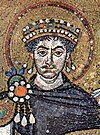
|
Justinian I
FLAVIVS PETRVS SABBATIVS IVSTINIANVS AVGVSTVS |
c. 482 AD,
Tauresium
,
Dardania
|
August 1, 527 AD – 13/14 November 565 AD |
Nephew and nominated heir of
Justin I
|
13/14 November 565 AD
Natural causes |

|
Justin II
FLAVIVS IVSTINIVS IVNIOR AVGVSTVS |
c. 520 AD, ? |
13/14 November 565 AD – 578 AD |
Nephew of
Justinian I
|
578 AD
Became insane;
Tiberius II Constantine
ruled as regent
from December 574 and became emperor on Justin’s death in 578 |
Roman Late Monogram Coins.htm
Roman AE4 Coins.htm
See also
-
Roman Republic
-
Roman Empire
-
Western Roman Empire
-
Byzantine Empire
-
Britannic Empire
-
Gallic Empire
-
List of Roman usurpers
-
Roman usurper
-
Thirty Tyrants (Roman)
|












